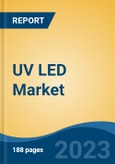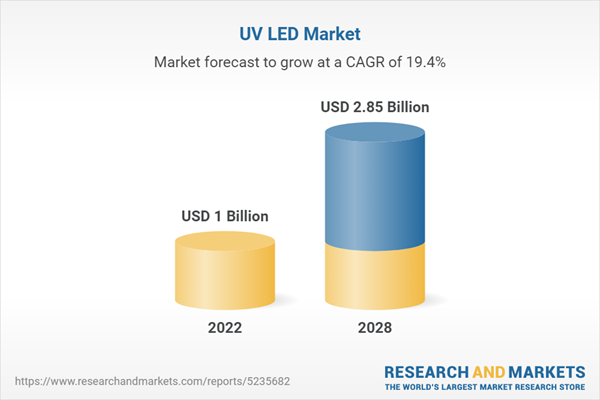Free Webex Call
The global UV LED market was valued at USD 1 billion in 2022 and is anticipated to project robust growth in the forecast period with a CAGR of 19.4% through 2028. The global UV LED market has been experiencing significant growth and is projected to continue its upward trajectory in the coming years. UV LED, or Ultraviolet Light Emitting Diode, technology offers numerous applications across various industries, leading to its increasing demand. Speak directly to the analyst to clarify any post sales queries you may have.
10% Free customizationThis report comes with 10% free customization, enabling you to add data that meets your specific business needs.
Key Market Drivers:
Growing demand for UV LED in disinfection and sterilization applications:
UV LEDs have gained prominence in the disinfection and sterilization industry due to their ability to effectively eliminate pathogens and microorganisms. With rising concerns regarding healthcare-associated infections and the need for proper sanitation, there has been an increased demand for UV LED-based germicidal lamps and systems. UV LEDs offer advantages such as energy efficiency, compact size, and a longer lifespan compared to traditional mercury-based UV lamps.
Increased focus on energy-efficient lighting solutions:
In recent years, there has been increasing emphasis on energy conservation and reducing carbon emissions. UV LEDs are highly energy-efficient compared to traditional lighting technologies and offer longer operational lifespans. This has led to their adoption in various lighting applications, including backlighting in displays, signage, and decorative lighting.
Growing demand for UV LED in water and air purification:
With the rising need for clean and safe drinking water, UV LED technology has gained traction in the water purification industry. UV LEDs effectively disinfect water by inactivating microorganisms, viruses, and bacteria without the use of chemicals. Additionally, UV LEDs are widely used in air purification systems to eliminate airborne pathogens, allergens, and volatile organic compounds (VOCs).
Increasing awareness of UV LED benefits
As awareness about the advantages of UV LED technology spreads, more industries and consumers are adopting this technology. UV LEDs offer benefits such as reduced energy consumption, longer lifespan, and enhanced safety compared to traditional UV lamps. This has led to their adoption in various sectors, including industrial manufacturing, automotive, agriculture, and electronics.Key Market Challenges
One of the key challenges in the global UV LED market is the high cost of UV LED technology compared to traditional UV lamps. UV LEDs are relatively expensive to manufacture due to the complex semiconductor processes involved. The high production costs result in higher product prices, which can deter potential buyers. Manufacturers in the UV LED industry need to focus on improving production efficiency and reducing costs to make UV LED technology more affordable and accessible.Another challenge is the limited wavelength range of UV LEDs. Different applications require specific wavelengths of UV light, and currently, UV LEDs are available in a limited range of wavelengths. This limitation restricts the scope of applications where UV LEDs can be effectively utilized. Research and development efforts are underway to expand the wavelength range of UV LEDs, but it will take time to develop commercially viable solutions.
The performance and reliability of UV LEDs need improvement. While UV LEDs offer several advantages over traditional UV lamps, such as longer lifespan and instant on/off capabilities, there are still concerns about their performance and durability. Issues like low light output, decreased efficiency at high temperatures, and shorter lifespans under certain operating conditions need to be addressed to enhance the overall performance and reliability of UV LEDs.
Lack of awareness and education is also a challenge that needs to be overcome.
There is a lack of awareness and education about the benefits and potential applications of UV LED technology. Many industries and consumers are not fully aware of the advantages of UV LEDs and how they can be utilized in various fields. Educating the market about the capabilities of UV LED technology and its potential to address environmental concerns and enhance operational efficiency is crucial for its widespread adoption.
Key Market Trends:
Growing Demand for UV-C LEDs for Germicidal Applications:
One of the key trends driving the global UV LED market is the rising demand for UV-C LEDs for germicidal applications. UV-C LEDs emit short-wavelength ultraviolet light that can deactivate or destroy microorganisms such as bacteria, viruses, and molds. The COVID-19 pandemic has further highlighted the importance of effective disinfection methods, leading to an increased adoption of UV-C LEDs in various industries, including healthcare, food and beverage, and water treatment.
Increasing Adoption of UV LEDs in Sterilization and Disinfection:
UV LEDs are being increasingly used for sterilization and disinfection purposes in various settings. The ability of UV light to eliminate harmful pathogens without the use of chemicals makes it an attractive solution in healthcare facilities, laboratories, and public spaces. UV LEDs can be integrated into devices such as handheld sterilizers, air purifiers, and surface disinfection systems, offering a convenient and efficient method for maintaining cleanliness and reducing the spread of infections.
Technological Advancements and Cost Reductions:
Advancements in UV LED technology have played a significant role in driving market growth. Manufacturers have been investing in research and development to improve the efficiency, output, and lifespan of UV LEDs. These advancements have resulted in higher performance and reduced costs, making UV LED technology more accessible to a wider range of applications. As a result, industries such as electronics, printing, and automotive are increasingly adopting UV LEDs for curing, printing, and other specialized processes.
Increasing Demand in Emerging Markets:
The global UV LED market is witnessing significant growth in emerging markets, particularly in the Asia Pacific region. Countries like China, Japan, and South Korea are major players in the production and adoption of UV LEDs. These markets are driven by factors such as increased industrialization, government initiatives promoting energy-efficient lighting, and growing awareness of the benefits of UV LED technology. The demand for UV LEDs in emerging markets is expected to continue growing as industries across various sectors seek innovative solutions for their lighting and disinfection needs.
Expanding Applications in Medical and Healthcare:
UV LEDs are finding expanding applications in the medical and healthcare sectors. They are used in phototherapy devices for the treatment of skin conditions such as psoriasis, vitiligo, and eczema. UV LEDs are also being explored for their potential in drug discovery, sterilization of medical equipment, and wound healing. The versatility of UV LEDs in medical applications opens up new opportunities for market growth in this sector.
Segmental Insights
Technology Insights
The global UV LED market is experiencing significant growth, with UV-C LED playing a key role. UV-C LED technology has gained traction due to its applications in germicidal and disinfection processes. The increasing demand for UV LEDs in air and water purification systems, healthcare, and consumer electronics is driving this market expansion. This growth trend highlights the importance of UV-C LED in various industries and its potential for further development in the coming years. Additionally, the benefits of UV-C LED technology extend beyond the healthcare sector. Industries such as water treatment, food and beverage, electronics, and manufacturing are adopting UV-C LEDs for various applications. These include water purification, surface disinfection, air sterilization, product curing, and more. The growing awareness of the advantages of UV-C LED technology, such as energy efficiency, longer lifespan, and reduced maintenance costs, has further fueled its adoption. Compared to traditional UV lamps, UV-C LEDs consume less power, have a longer operating life, and do not contain harmful mercury or ozone-depleting substances.Application Insights
The global UV LED market is fueled by the curing segment, which plays a significant role in driving its growth. UV LED curing technology offers numerous advantages over traditional curing methods, such as faster curing times, energy efficiency, and reduced environmental impact. It finds applications in industries like printing, coatings, adhesives, and electronics manufacturing. UV LED curing systems emit ultraviolet light that initiates a photochemical reaction, curing or drying the materials within seconds. This rapid curing process leads to increased productivity and efficiency in manufacturing processes. UV LED curing also eliminates the need for solvents or heat, reducing energy consumption and eliminating harmful emissions. Furthermore, advancements in UV LED curing technology have expanded its capabilities and application range. Manufacturers are developing UV LED systems with higher power output, broader wavelength ranges, and improved curing performance. These advancements open up new opportunities for UV LED curing in different industries and enable the curing of a wider range of materials.Regional Insights
The global UV LED market is experiencing significant growth, and Asia Pacific plays a vital role in driving this expansion. The Asia-Pacific region is poised for significant market growth during the forecast period. Notably, vendors in Japan and China are making substantial investments in the expanding applications of UV LEDs. In China, prominent ink manufacturers like Toyo Ink Co. Ltd, DIC Corporation, and Japanese chemical companies operating in China have underscored the rising demand for ultraviolet inks. This demand is driven by environmental advantages and faster curing rates. For instance, end-user industries such as wine and cigarette packaging printing rely on ultraviolet LEDs to print on materials like aluminum foil, paper, and plastic. Furthermore, the Chinese central government anticipates automobile production in China to reach 35 million units by 2025. This growth is expected to drive the demand for ultraviolet LEDs, particularly in applications like painting in the automotive sector. In contrast, ultraviolet LEDs have a significantly longer lifespan, lasting over ten times longer with lifespans exceeding 10,000 hours.Key Market Players
- Honle UV America Inc.
- Seoul Viosys Co. Ltd
- Semileds Corporation
- EPIGAP Optronic GmbH
- Lumileds Holding BV
- Koninklijke Philips NV
- Nordson Corporation
- Nichia Corporation
- CRYSTAL IS Inc.
- Heraeus Holding GmbH
Report Scope:
In this report, the global UV LED market has been segmented into the following categories, in addition to the industry trends which have also been detailed below:Global UV LED Market, By Technology:
- UV-A LED
- UV-B LED
- UV-C LED
Global UV LED Market, By Application:
- Curing
- Disinfection & Purification
- Medical
- Security
- Others
Global UV LED Market, By Region:
- North America
- Europe
- South America
- Middle East & Africa
- Asia Pacific
Competitive Landscape
Company Profiles: Detailed analysis of the major companies present in the Global UV LED Market.Available Customizations:
Global UV LED Market report with the given market data, the publisher offers customizations according to a company's specific needs.This product will be delivered within 1-3 business days.
Table of Contents
1. Product Overview2. Research Methodology3. Impact of COVID-19 on Global UV LED Market4. Executive Summary12. Market Trends and Developments13. SWOT Analysis16. Strategic Recommendations17. About the Publisher & Disclaimer
5. Global UV LED Market Outlook
6. North America UV LED Market Outlook
7. Europe UV LED Market Outlook
8. South America UV LED Market Outlook
9. Middle East & Africa UV LED Market Outlook
10. Asia Pacific UV LED Market Outlook
11. Market Dynamics
14. Voice of Customer
15. Company Profiles
Companies Mentioned (Partial List)
A selection of companies mentioned in this report includes, but is not limited to:
- Honle UV America Inc.
- Seoul Viosys Co. Ltd
- Semileds Corporation
- EPIGAP Optronic GmbH
- Lumileds Holding BV
- Koninklijke Philips NV
- Nordson Corporation
- Nichia Corporation
- CRYSTAL IS Inc.
- Heraeus Holding GmbH
Table Information
| Report Attribute | Details |
|---|---|
| No. of Pages | 188 |
| Published | September 2023 |
| Forecast Period | 2022 - 2028 |
| Estimated Market Value ( USD | $ 1 Billion |
| Forecasted Market Value ( USD | $ 2.85 Billion |
| Compound Annual Growth Rate | 19.4% |
| Regions Covered | Global |









